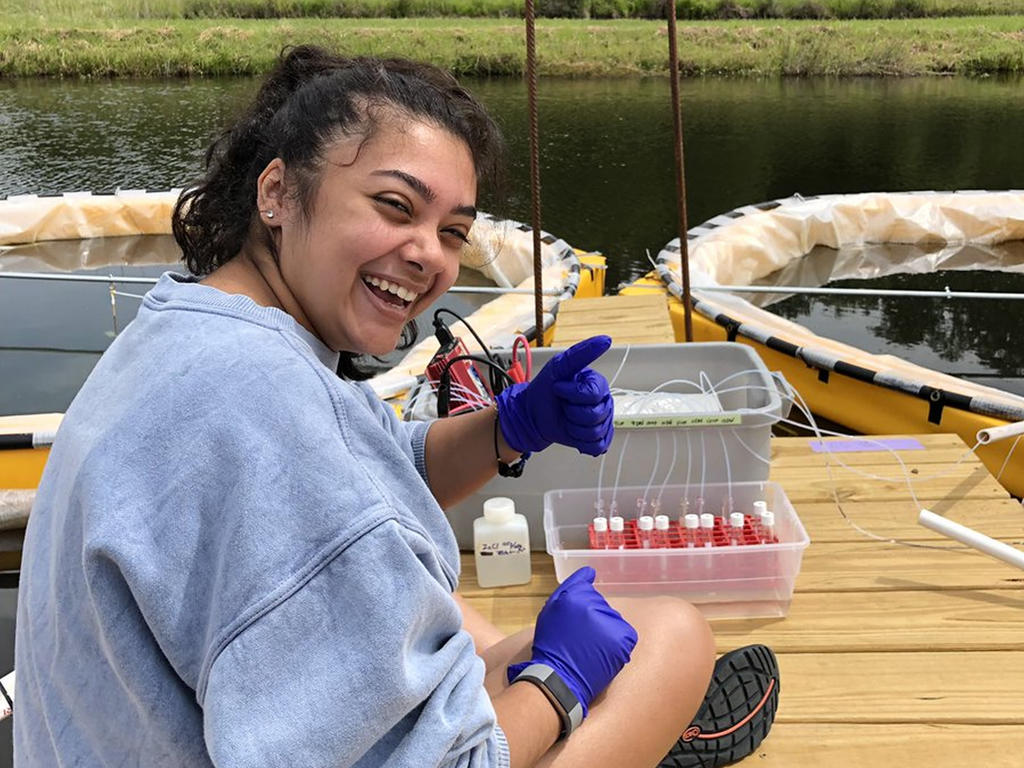Driven by a love of being outdoors and on the water, environmental science major Bernadette Badamo contacted assistant biology professor Dr. Patrick Kelly last year about assisting him with his research on aquatic ecosystems. As a result, she has spent this summer in a canoe measuring sources of organic carbon in Mid-South area lakes to analyze how these lakes store and release carbon and how they cycle nutrients.
“To scientists, this is important because we characterize ecosystems based on carbon balance. In lakes, this is important because they receive a lot of nutrients and carbon from the landscape, so we want to understand what influence they have on the lakes,” says Badamo. “This can be important to the general public, because this has implications for greenhouse gas emissions.”
The carbon cycle involves the movement of carbon in and out of air, water, and land and its interactions with organisms such as plants and animals. Carbon attached to oxygen forms a gas called carbon dioxide (CO2). Plants take CO2 from the air to make food and release oxygen, a process called photosynthesis. Animals take in oxygen and release CO2 by breaking down sugars, a process called respiration. Too much carbon emission from humans or the natural environment, however, traps heat in the atmosphere, contributing to climate change. Lakes can be an important part of this process, contributing greatly to the global carbon cycle. A number of things impact lake carbon cycling, including nutrients from the landscape that may also reduce water quality and clarity.
“We are putting sensors in the lakes and measuring dissolved oxygen throughout the day,” says Badamo. “We use those data to estimate rates of primary production—taking carbon dioxide out of lakes and turning it into biomass—and respiration—turning biomass into carbon dioxide.” The lakes from which Badamo and Kelly have been taking samples include Epping Way, Poplar Tree, Glenn Springs, Whiteville, and Herb Parsons in Tennessee; Arkabutla and Chewalla in Mississippi; and Horseshoe in Arkansas.
Badamo says she has soaked up knowledge about how lakes and their food webs function in response to the external environment. “Bernadette has been integral to the research projects going on in my lab,” says Kelly. “She has an incredible work ethic, is curious and very competent, and picks up on field work protocols right away and never needs to be shown how to do something twice. I could not have collected the amount of data I did this summer without her assistance.”
The researchers also have been journeying to the University of Mississippi field Station near Oxford, MS, to conduct an ongoing experiment focused on how different amounts of nutrients contribute to harmful algal blooms in lakes. This research is being done in collaboration with research ecologist Dr. Jason Taylor at the U.S. Department of Agriculture and Dr. Thad Scott, an associate professor of biology at Baylor University.
Common nutrients in lakes are nitrogen and phosphorus, which can be found in fertilizers, storm water, sewage, and animal waste. Too many nutrients induce the growth of algal blooms beyond what is needed for the fish, animals, and organisms in the ecosystem to eat. Microorganisms, in breaking down excess bloom that have died, consume the oxygen that is needed by the fish or other aquatic organisms causing them to die (a process called eutrophication).
At the University of Mississippi field station, the Rhodes researchers collect small floating organisms in 12 enclosed pools of water called limnocorrals. Each one is treated with a different ratio of nitrogen to phosphorus to see the response. “Because of the eutrophication issues across the globe, leading to poor water quality and reduced ecosystem services, scientists are really interested in how different ratios of nutrients contribute to harmful algal blooms,” says Kelly. “The outcome of this will hopefully have real-world implications for how farmers and managers think about fertilizer inputs in the environment.
“The outcomes of both projects will contribute to the scientific community’s understanding of nutrient cycling, carbon processing, and how food webs react to nutrient loads,” adds Kelly. “These projects may also have important implications for the general public and lead to management decisions for how we use and improve the lakes in our local areas.”
